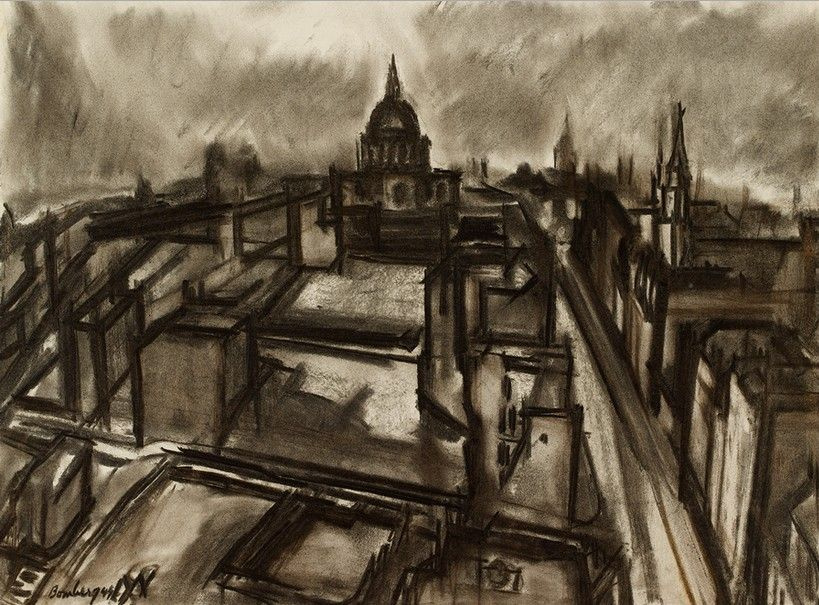Vorticism (it. vortice — whirlwind, vortex) is the direction of the English avant-garde
, which originated in 1914. Its name was chosen by the Italian futurist Umberto Boccioni who claimed that all creative art emanated from an emotional vortex.

The art history had several styles that did not exist long enough for many critics to take them seriously. Vorticism existed for only a few years, and then it was forgotten for almost a century — till the 2011 when Tate Britain hosted the exhibition dedicated to this style. It raised both interest in the Vorticism artists and the price of their works.

Vorticism is a purely English phenomenon.
Its main ideologist was the artist Percy Wyndham Lewis, who believed that impressionism
did not make it possible enough to reflect the realities of the pre-war world. Lewis loved cubism
and futurism
, but at the same time he cherished the ambition of creating his signature style — that is how vorticism appeared.
Key features
Dynamism, sharpness, angularity were of primary importance. Human silhouettes were simplified to the plaine geometric shapes with clear edges and a limited number of colours without any subtones. The colours are usually juicy, but not bright, often the range is such that it does not irritate the eye, but causes anxiety, tension.Like the futurists, the vorticists tried to reflect the mobility of the world in their works, but this movement is often directed to the centre; it seems as if the canvas is spinning in a centrifuge. They struggled with realism , in their works people are depicted mostly schematically as clusters of simple geometric shapes ("stickman").
As for the subjects, there were few cars on the canvases, but quite a lot of people or buildings. Moreover, the lines, as a rule, were not smooth, but rather sharp. A common message was the desire to paint an industrial city in a negative way, to show how it kills individuality in a person. A typical example is the work by artist David Bomberg.
The main difference from the Italian fellow artists was that the futurists hailed progress, whereas the vorticists analyzed its influence on European civilization and did not consider it a positive phenomenon. They claimed that industrialization had a bad effect on human personality.

The printed voice of the Vorticist union was The Blast magazine. The cover of the second issue with a woodcut by Percy Wyndham Lewis was dedicated to the war. The magazine was published in 1915.
The style existed only a few years and did not even live to see the end of the First World War, however, it played an important role as a stage in the formation of abstract art in England.
Famous vorticism artists
Percy Wyndham Lewis, Lawrence Atkinson, Henri Gaudier-Brzeska, Edward Wadsworth, David BombergIconic paintings
David Bomberg’s "The Mud Bath" 1914, Tate Britain, 15.24×22.42 cm. In the picture, people are depicted schematically, but the play of geometric shapes and colours creates the illusion of volume, depth of the canvas.Lawrence Atkinson’s "The Lake" circa 1915. The abstract picture causes a lot of illusions, depending on the viewing angle, the lake resembles either a staircase or a piano. This is an ideal example of the "vortex" effect of vorticism, when attention is drawn to the centre of the picture, like in a funnel.
You’re an expert, if:
— you have looked through the gallery of David Bomberg’s works and caught the difference between the canvases of the futurist and the vorticist. On the first ones, technological progress is praised, on the second ones, the "concrete-technical" world is shown to press on person. The methods are similar, the idea is different.
You’re a layman, if:
— you think that vorticism is just a branch of futurism. However, this is an independent modernist movement. With futurism , they have common methods, but not an idea. Moreover, vorticism was popular in England, futurism in Italy and Russia. If in doubt, see the country, in which the author worked, this helps determine the style of work.
— you have looked through the gallery of David Bomberg’s works and caught the difference between the canvases of the futurist and the vorticist. On the first ones, technological progress is praised, on the second ones, the "concrete-technical" world is shown to press on person. The methods are similar, the idea is different.
You’re a layman, if:
— you think that vorticism is just a branch of futurism. However, this is an independent modernist movement. With futurism , they have common methods, but not an idea. Moreover, vorticism was popular in England, futurism in Italy and Russia. If in doubt, see the country, in which the author worked, this helps determine the style of work.

















